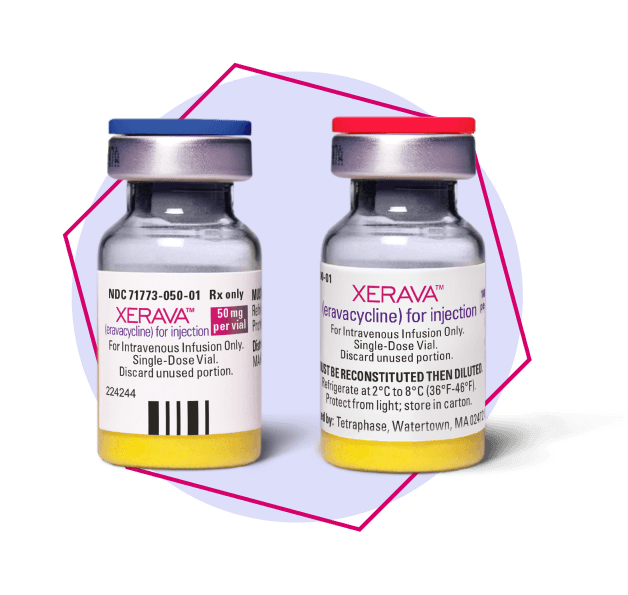XERAVA Dosing
Convenient dosing for
more of your patients
Dosing & Administration
Dosage and administration
for adult patients (≥ 18 years of age) with cIAI
12 hours
by IV infusion
- The recommended duration of treatment is 4 to 14 days
- The duration of therapy should be guided by the severity and location of infection and the patient's clinical response
No dosage adjustment is necessary in patients with renal impairmentNo dosage adjustment is necessary in patients with renal impairment
IV=intravenous.
*Actual body weight.
Dosage in specific populations
Well-positioned for effective
transitions of care
Convenient dosing is optimal for transitions of care between inpatient and outpatient settings
Twice-daily dosing for adult patients
(≥ 18 years of age) with cIAI
No therapeutic drug monitoring
required
No renal dose adjustment required
Stable for 8 days if stored refrigerated at 2°C to 8°C (36°F to 46°F)
Administration of the
intravenous infusion
The diluted XERAVA solution is administered as an intravenous infusion over approximately 60 minutes.
XERAVA may be administered intravenously through a dedicated line or through a Y-site. If the same intravenous line is used for sequential infusion of several drugs, the line should be flushed before and after infusion of XERAVA with 0.9% Sodium Chloride Injection, USP.
Preparation
How it’s supplied
- XERAVA for injection is a yellow to orange, sterile, preservative-free powder for reconstitution in single-dose 10-mL clear glass vials with a rubber stopper and an aluminum overseal
- Each vial contains either 50 mg or 100 mg of eravacycline

how to prepare
XERAVA is for intravenous infusion
only. Each vial is for a single dose only.
Aseptic technique must be used for reconstitution and dilution as follows:
Storage
How to store
Prior to reconstitution, XERAVA should be stored at 2°C to 8°C (36°F–46°F). Keep vial in carton until use
The stability of the solution after reconstitution in the vial has been demonstrated for 1 hour at room temperature (not to exceed 25°C/77°F)
If the reconstituted solution in the vial is not diluted in the infusion bag within 1 hour, the reconstituted vial content must be discarded
Diluted solutions in the infusion bag must be infused within 12 hours if stored at room temperature (not to exceed 25°C/77°F) or within 8 days if stored refrigerated at 2°C to 8°C (36°F–46°F)
Reconstituted XERAVA solutions and diluted XERAVA infusion solutions should not be frozen
Want to
know more?
Request to speak with a
XERAVA sales representative
or receive information.
Lead the
charge
Choose broad-spectrum
coverage for a broad range of
cIAI patients with XERAVA.1
Reference:
- Zhanel GG, Cheung D, Adam H, et al. Review of eravacycline, a novel fluorocycline antibacterial agent. Drugs. 2016;76(5):567-588. doi: 10.1007/s40265-016-0545-8.
Indications & Usage
Indications
XERAVA® (eravacycline) for injection is indicated for the treatment of complicated intra-abdominal infections (cIAI) caused by susceptible microorganisms: Escherichia coli, Klebsiella pneumoniae, Citrobacter freundii, Enterobacter cloacae, Klebsiella oxytoca, Enterococcus faecalis, Enterococcus faecium, Staphylococcus aureus, Streptococcus anginosus group, Clostridium perfringens, Bacteroides species, and Parabacteroides distasonis in patients 18 years or older.
Limitations of Use XERAVA is not indicated for the treatment of complicated urinary tract infections (cUTI).
Usage
To reduce the development of drug-resistant bacteria and maintain the effectiveness of XERAVA and other antibacterial drugs, XERAVA should be used only to treat or prevent infections that are proven or strongly suspected to be caused by susceptible bacteria. When culture and susceptibility information are available, they should be considered in selecting or modifying antibacterial therapy. In the absence of such data, local epidemiology and susceptibility patterns may contribute to the empiric selection of therapy.
Important Safety Information
XERAVA is contraindicated for use in patients with known hypersensitivity to eravacycline, tetracycline-class antibacterial drugs, or to any of the excipients. Life-threatening hypersensitivity (anaphylactic) reactions have been reported with XERAVA.
The use of XERAVA during tooth development (last half of pregnancy, infancy and childhood to the age of 8 years) may cause permanent discoloration of the teeth (yellow-gray-brown) and enamel hypoplasia.
The use of XERAVA during the second and third trimester of pregnancy, infancy and childhood up to the age of 8 years may cause reversible inhibition of bone growth.
Clostridioides difficile associated diarrhea (CDAD) has been reported with use of nearly all antibacterial agents, and may range in severity from mild diarrhea to fatal colitis.
The most common adverse reactions observed in clinical trials (incidence ≥3%) were infusion site reactions (7.7%), nausea (6.5%), and vomiting (3.7%).
XERAVA is structurally similar to tetracycline-class antibacterial drugs and may have similar adverse reactions. Adverse reactions including photosensitivity, pseudotumor cerebri, and anti-anabolic action which has led to increased BUN, azotemia, acidosis, hyperphosphatemia, pancreatitis, and abnormal liver function tests, have been reported for other tetracycline-class antibacterial drugs, and may occur with XERAVA. Discontinue XERAVA if any of these adverse reactions are suspected.
You are encouraged to report negative side effects of prescription drugs to the FDA. To report SUSPECTED ADVERSE REACTIONS, please contact:
Innoviva Specialty Therapeutics, Inc.™
1‑800‑651‑3861
U.S. Food and Drug Administration
1‑800‑FDA‑1088
Before administering, please see the Full Prescribing Information for XERAVA.